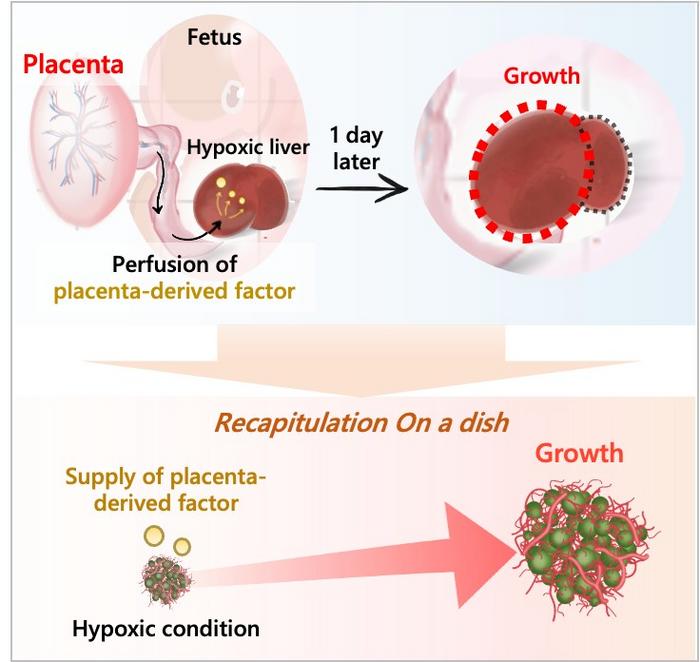In a groundbreaking study published in Nature Communications, researchers have unveiled a significant breakthrough in the field of organoid technology, particularly focusing on liver organoids derived from human induced pluripotent stem cells (hiPSCs). Traditionally, the development of organoids that adequately mimic the functionality of their in vivo counterparts has been hampered by limitations in size, complexity, and functionality. However, this innovative research team, spearheaded by Dr. Yoshiki Kuse and Prof. Hideki Taniguchi from The Institute of Medical Science, The University of Tokyo, has successfully shown that placenta-derived factors can substantially enhance the growth and functionality of liver organoids, addressing a crucial challenge that has long plagued the field.
The journey into organoid research reveals its growing importance within biomedical science. Organoids serve as miniature models of organs, providing invaluable insights into human biology, disease mechanisms, and potential therapeutic approaches. Derived from hiPSCs, which can differentiate into any cell type, organoids offer a promising avenue for regenerative medicine. However, generating organoids that are sufficiently large and functionally mature has posed significant barriers, primarily due to the complexity of cellular interactions and the intricate signaling pathways that govern tissue development. This pivotal study highlights the potential of placenta-derived factors in overcoming these challenges, illustrating a sophisticated approach to organoid development.
At the core of this research lies a detailed investigation into the role of the placenta during fetal development. The placenta is known to supply not only nutrients and oxygen but also an array of growth factors crucial for organ growth. The research team sought to unlock the mechanisms behind these processes by exploring the specific interactions between placental factors and developing tissues. By concentrating on the early stages of liver development, they highlighted a critical period in mouse embryos where localized blood perfusion and low-oxygen conditions prevail, influenced by the secretion of various placental growth factors.
Through a meticulous experimental framework, the researchers identified a key protein among the placental factors: IL1α. Previous studies had hinted at the role of IL1α in cellular signaling, yet its application in liver organoid growth had not been adequately explored. In their experiments, the team introduced IL1α to hiPSC-derived liver organoids while simulating the hypoxic conditions that characterize early liver development, followed by controlled reoxygenation. This approach yielded astonishing results—the organoids exhibited growth up to five times larger than control groups, alongside enhancing functional characteristics such as increased production of liver-specific proteins.
The implications of these findings are vast, suggesting that IL1α not only spurs growth but also acts to amplify the proliferation of hepatoblasts, the liver progenitor cells critical for liver growth. This advancement sheds light on how a careful recapitulation of developmental biology can drive organoid expansion. Dr. Kuse emphasized the strategic integration of placental factors as instrumental in advancing liver organoid culture techniques, fundamentally altering the landscape of organoid research.
Delving deeper into the molecular mechanisms, the research employed single-cell RNA sequencing analysis to unveil the intricate signaling pathways influenced by IL1α. The study identified the SAA1-TLR2-CCL20-CCR6 signaling cascade as a pivotal route through which IL1α facilitates hepatoblast expansion. These findings offer a granular perspective on how external growth factors can modulate liver organogenesis, suggesting potential applications that extend beyond liver organoids to other organ types as well. This opens the door to novel personalized medicine approaches, where tailored organoid models could reflect individual patient biology for improved therapeutic outcomes.
The study’s significance does not only lie in its immediate results but also in the methodological advancements it proposes for future organoid research. The researchers argue that while their approach is revolutionary, full replication of in vivo liver development remains a challenge. They advocate for the design of perfusion-based culture systems that can continuously deliver placenta-derived factors, thereby enhancing the viability and complexity of organoid cultures. By more closely mimicking the dynamic conditions of fetal development, future studies could further refine organoid technology, paving the way for revolutionary applications in transplantation and regenerative therapy.
Current biomedical challenges underscore the importance of innovative solutions to organ development. The potential to utilize placenta-derived factors could dramatically shift the paradigms of organoid research, particularly in creating models for disease study and drug testing. As researchers push the boundaries of what is possible with hiPSC-derived organoids, the insights gained from this study illuminate the pathway towards scalable and functionally robust organ systems, crucial for advancing therapeutic strategies.
Collaboration across disciplines will be essential in harnessing the full potential of these findings. By engaging in interdisciplinary partnerships, scientists can glean insights from developmental biology while integrating cutting-edge technologies into organoid research. The success of placenta-derived factor applications could be foundational, not only for enhancing organoid growth but for elucidating the fundamental principles of organ development and regeneration.
In summary, the breakthrough demonstrated by the research group led by Dr. Kuse fundamentally modifies our understanding of organoid development. Utilizing placental factors signifies a new frontier in organoid technology, promising to catalyze advancements in regenerative medicine and transplantation strategies. As the scientific community continues to explore the complexities of organ development, this research stands as a significant milestone, offering both immediate applications and future implications for medical science.
The implications of this study resonate far beyond academia, as the promise of organoid technology hints at revolutionary changes in healthcare practices. By overcoming the limitations associated with organ growth and functionality, the potential for lab-grown organs and tailored treatment strategies could become a tangible reality. The world watches keenly as researchers venture further into this exciting domain, bridging the chasm between basic science and clinical application, steadily moving closer to groundbreaking advancements that could reshape our understanding of human biology and regenerate medicine.
Subject of Research: Animals
Article Title: Placenta-derived factors contribute to human iPSC-liver organoid growth
News Publication Date: 13-Mar-2025
Web References: https://doi.org/10.1038/s41467-025-57551-w
References: DOI: 10.1038/s41467-025-57551-w
Image Credits: Dr. Yoshiki Kuse from The Institute of Medical Science, The University of Tokyo, Japan
Keywords: Stem cell development, clinical research, discovery research, organoids, medical research facilities, stem cell research, placenta.




